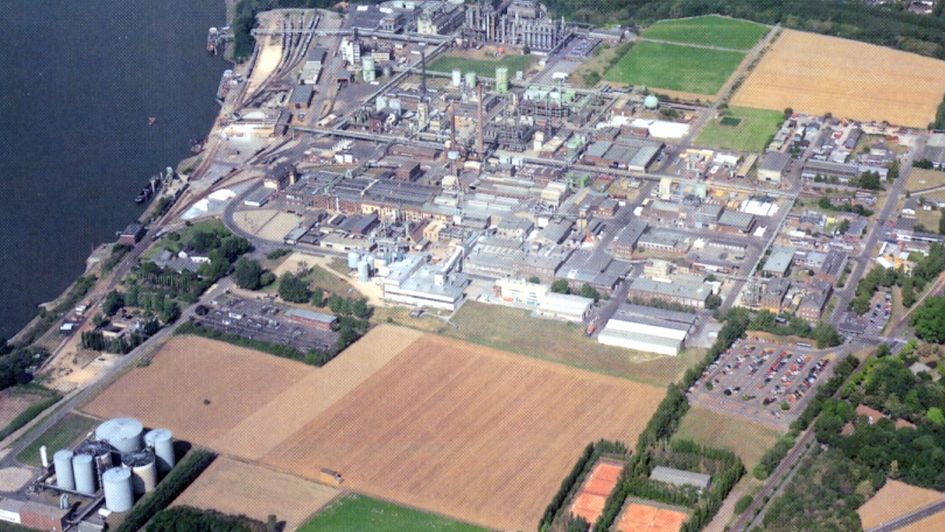Founding on a greenfield site
Lülsdorf
The history of the Lülsdorf factory goes back to November 7, 1912, when the Deutsche Wildermannwerke, chemische Fabriken GmbH, a subsidiary of the Stinnes Group, was founded on a greenfield site. The name came from the shareholder and chemist Dr. Meyer-Wildermann. The process of electrolyzing potash and sodium, developed by Hugo Stinnes in 1910, in the cellulose factory in Waldhof near Mannheim, formed the core of the new company. This process used the electric current from the Stinnes Group “Vorgebirgszentrale” lignite power station. The other shareholders in Deutsche Wildermannwerke were also Stinnes subsidiaries: the Deutsch-Luxemburgische-Bergwerks- und Hütten AG, the Rheinisch-Westfälische Elektrizitätswerk AG (RWE) and the Gewerkschaft Zeche Mathias Stinnes.
In geographical and economic terms, the land on which the new factory was built was good as it was not prone to flooding, on the right-hand bank of the Rhine, opposite Wesseling near Cologne. However, it was not possible to recruit labor from the local area. At the time, local people opposed the construction of the electrolysis plant and preferred to work the land. The workforce was therefore recruited from a wider area and was accommodated in specially built housing developments.
The cells developed by Dr. Meyer-Wildermann needed to be lined with high-quality rubber. After WWI broke out and the Allies set up blockades, it was still possible to transport this rubber from the USA by merchant submarine. Advised by Friedrich-Wilhelm Minoux, Hugo Stinnes planned from 1917 the transition to the more economical Siemens Billiter cells. Dr. Meyer-Wildermann unsuccessfully opposed this action and was replaced by Minoux as Chief Executive. During WWI, the factory in Lülsdorf produced mainly potassium chlorate along with the electrolysis products. One of the uses of potassium chlorate is in the manufacture of explosives.

In 1920, during the course of a radical restructuring of the Stinnes Group, the Lülsdorf factory became part of “Koholyt AG” which was founded in 1917. Hugo Stinnes sen. integrated all the coal and wood processing and electrolysis processes into this company. Friedrich-Wilhelm Minoux was again appointed chief executive.
The manufacture of corundum, which is used mainly as an abrasive in the iron working industry, was concentrated increasingly in Lülsdorf and expanded in the course of the 1920s. Corundum production did not cease until 1995.
Hugo Stinnes sen. died on April 10, 1924 leaving a widely ramified but insolvent group that had been financed solely through loans. In 1926, the factory in Lülsdorf was sold as part of Koholyt AG to the English company Inveresk Paper Co. Ltd.
During the global economic crisis, the cellulose and paper company Feldmühle AG, which at that time was the largest in Germany, acquired Koholyt AG in 1930. From then on, the factory in Lülsdorf traded as “Feldmühle, Papier- und Zellstoffwerke AG Werk Koholyt Lülsdorf.” The new owners expanded the existing production capacity.
In WWII, prisoners of war and forced labor from Ukraine, Poland, Italy, Belgium, the Netherlands and Spain were increasingly employed in Lülsdorf.
Expansion after the war
In 1950 the product range was enhanced with potash, a move supported particularly by Hugo Stinnes jun. as the chairman of the Board of Directors at Feldmühle AG. The construction of a refinery was planned but not realized, as it would have overstretched the company’s financial resources.
Increases in production demanded more workers, who were housed in new, factory-owned homes. As early as 1919, so many employees had moved to the area that a facility for social events and dances was built. In 1920, the “Deutsche Wildermann-Werke Lülsdorf am Rhein Men’s Choir“ was founded which exists to this day but under a different name.
A significant name change occurred at the end of 1959 when Feldmühle AG acquired a large share of the Dynamit Aktiengesellschaft (previously Alfred Nobel & Co.). The factory in Lülsdorf was integrated into a new production group, which in 1962 became significant in company law terms. The factory was called from then on “Dynamit Nobel AG, Werk Feldmühle Lülsdorf,” as it had been leased by Feldmühle AG. The chlorine electrolysis process at Lülsdorf was of particular value to Dynamit Nobel, a manufacturer of PVC, as it meant that it could produce the monomer vinyl chloride itself, which previously had been additionally purchased. Starting in 1963, ethylene was transported to the Lülsdorf factory via pipes in a conduit under the Rhine from the refinery in Wesseling (now Shell, previously UK Wesseling). This allowed the factory in Lülsdorf to produce 1,2-Dichloroethane (EDC), an initial component of vinyl chloride.
Enhancement of product range
Lülsdorf had already moved away from just producing base substances in 1953/54 when research started into alkali alcoholates, derivatives of the electrolysis process. Production started in 1957. Adding sodium aluminate heralded the start of specialty chemistry in electrolysis. Between 1959 and 2000, Lülsdorf continued to pursue this strategy. Starting in 1962, the alcoholates were processed further to create the orthoesters trimethyl orthoformate (TMOF) and triethyl orthoformate (TEOF), which are still produced today.
In 1967, production of dimethyl terephthalate, an initial component of polyester, was added from the Dynamit Nobel factory in Witten. It was at this time that the range of products from the Lülsdorf factory was at its broadest. In the following years, existing production capacity was expanded and the group network consolidated.
In 1968, Dynamit Nobel acquired the land that it had previously rented from Feldmühle AG. From then on, the Lülsdorf factory was called “Dynamit Nobel AG, Werk Lülsdorf.” In 1988, it was sold with the chemical section of Dynamit Nobel AG to Hüls AG and traded from then on under the name “Hüls AG, Werk Lülsdorf.” Following two mergers, Lülsdorf has been an important site of Evonik Industries since September 2007.
